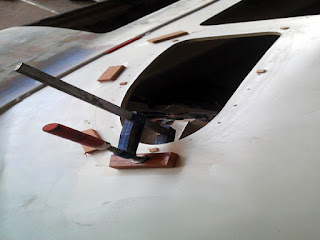The underwater sections of the hull all read dry with my moisture meter, except for an area below the kitchen floor. The kitchen floor consisted of foam and a layer of glass. I peeled back the glass:
You can see staining from water. I removed all the foam. The original builder of the boat fitted a floor this way. It's a bad idea. Bilge areas need to be dry and ventilated, or moisture builds up in the glass. Nothing is entirely waterproof - even epoxy coated hulls. Some water always passes through into the glass. If the water can evaporate from the inside as fast as it penetrates from the outside, it can't build up to a level that will allow osmosis to begin. Having water on the inside of a hull as well as the outside makes osmosis inevitable.
Anyway, it was a simple matter to remove the foam, and lay down a more traditional plywood floor. I first epoxied in some supports which greatly strengthen the hull right over the keel shoe I fitted, so that was a nice benefit of the new arrangement. And I think the finished floor looks a lot nicer than the old fibreglass one:
Note the foot pump I fitted by the step, to supply water to the sink. There used to be a hand pump, but washing your hands when one of them is occupied pumping water is just silly. And the pump was flimsy too. This Whale footpump is much more robust, and allows for a great deal of control when hand washing - this is important to me. The more frugal I can be with water, the less I need to carry. Less weight, more speed, or the ability to carry other essentials.
So, I got carried away. New worktops - normal domestic worktops which I modified for a multihull - ie, lightening them as much as possible by using a router to remove much of the chipboard under the surface, and then sealing the chipboard and all edges with epoxy resin.
New hob too. Cookers for boats used to be very expensive. Gas is heavier than air, and any gas leaking ends up in the bilge, waiting to blow a boat apart. So marine cookers need to be fitted with flame failure devices that turn off the gas if the flame goes out. That has now become the required way to supply domestic cookers too, so a stainless domestic cooker is just as good as an expensive 'marine' cooker from a chandler.
I'll make a stainless fiddle that hinged up against the bulkhead that will keep pans in place when the boat is sailing fast through bumpy water. Usually, fiddles aren't needed in a multihull, but I did once lose my chip pan when I hit a rough patch in the Gibraltar Straits. That was messy. So fiddles will be made and installed.
Only two burners on the hob, but I figured that with with a new grill and oven too, we'd manage OK. The little door beside the oven used to be a fridge. Silly place for a fridge, next to the oven. Not sure if a fridge is such a good idea for a cruising boat anyway. It's a big power draw which needs feeding with more batteries and solar panels - more expense, weight, and things to go wrong. I've got by just fine with several summers in the Mediterranean without a fridge, and never missed it. There are other ways to keep things fresh (wrap cheese in cloth, not plastic, keep cabbages and lettuces upside down in nets, allow plenty of air to circulate round fruit and vegetables, and sprout mung beans or alfalfa for salads and stir fries).
Cupboards. 10 of them altogether, 2 drawers, and a great big space under the cooker than could easily take a couple of sacks of potatoes. That space under the cooker used to house a waste water tank, which needed to be pumped out. I got rid of the tank, the pump and two underwater through hull fittings. There are a couple of places that don't allow disposal of washing up water into the sea. I won't go to those places.
Marine taps are expensive too, so I bent a bit of copper pipe. I think it looks quite nice. Well, water comes out of the end and without leaking anywhere else, when you pump the foot pump. And the tap can be turned away from the sink to over the step, when you need to fill a large container.
Just under the tap is a little box with a green light on. The light turns red and the box screams when it detects gas. Handy, just in case a flame failure device on the cooker fails.
This gas detector works very well, but I'm not sure what gas it tests for. It surprised me one day as I was working on the kitchen floor. I was down there on my knees, and did a little fart, and then this piercing alarm went off. I ran around for a little while before I realised what the alarm was, and why it had gone off. :)
That's a big kitchen for a 30' boat. But on a long voyage, there often isn't much to do except read and cook. So the kitchen to me is very important, much as I like reading.


















































